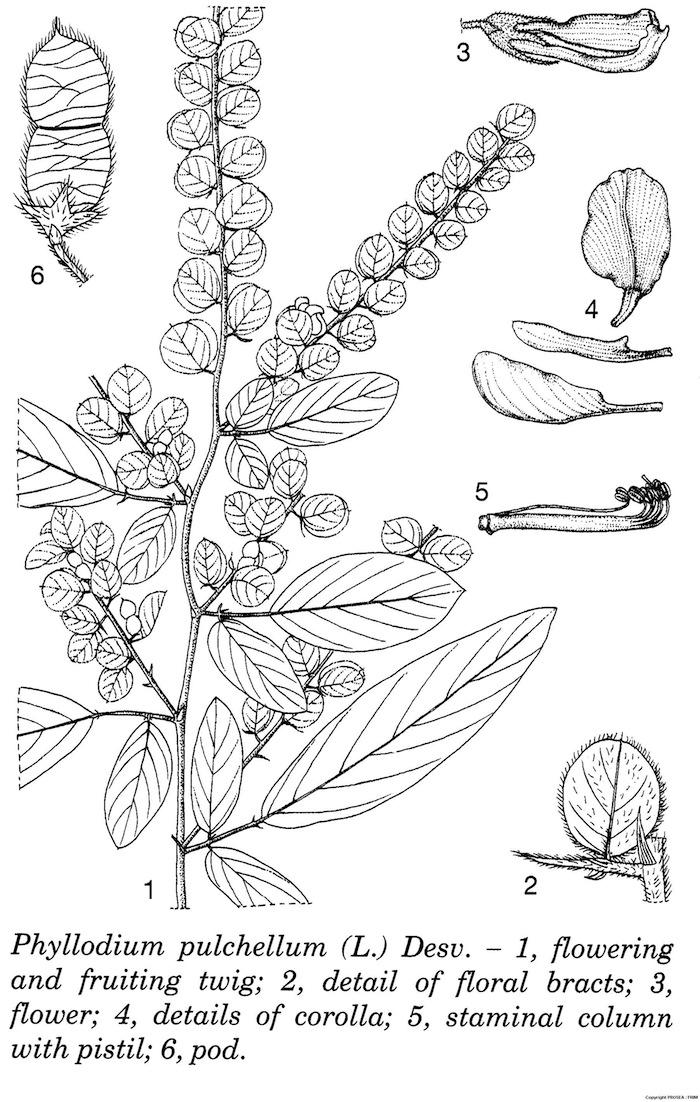Scientific Name
Phyllodium pulchellum (L.) Desv.
Synonyms
Desmodium pulchellu (L.) Benth. [Spelling variant], Desmodium pulchellum (L.) Benth., Dicerma pulchellum (L.) DC., Hedysarum pulchellum L., Meibomia pulchella (L.) Kuntze, Zornia pulchella (L.) Pers. [1]
Vernacular Name
| Malaysia | Serengan kechil (Peninsular) [2][3] |
| China | Pai qian shu [3] |
| India | Chipoto, dhekna, hampilla, jatasalaparni, kaduhuralite, kondontinta, nipithu, sarivi, seegate gida, survi, thigari, tiga velaga, ummah, ursi, vellalothi [3] |
| Indonesia | Apa-apa, apaapa sapi, ketipes (Javanese) [2] |
| Thailand | Klet plaa chon, yaa song plong (Central); yaa klet lin (Northern, Peninsular) [2] |
| Laos | Kéd linz no:yz (Vientiane) [2] |
| Philippines | Gaan-gaan (Sulu); kalaikai (Cebu); payang-payang (Tagalog) [2] |
| Cambodia | âng-prôm, praè kraôy [2] |
| Vietnam | Chu[oox]i ti[eef]n, d[oof]ng ti[eef]n [2] |
| Japan | Uchiwa-tsunagi [3]. |
Geographical Distributions
Phyllodium pulchellum is distributed from India, Sri Lanka, Southern China, Taiwan and the Ryukyu Islands throughout Southeast Asia, Northern Australia and the Solomon Islands. [2] P. pulchellum is found in teak forests, thickets, dry grassy fields, and sometimes along watercourses up to 900(-1600) m altitude. [2]
Botanical Description
P. pulchellum is a member of the Leguminosae family. It is a shrub that can grow up to 2.5 m tall. Its branches are slender, cylindrical and pubescent. [2]
The leaves are 3-foliolate, with petiole 6-10 mm long, narrowly triangular stipules, measuring 6-8 mm x 2-3 mm, with rachis 10-20 mm long, with ovate terminal leaflet, elliptical or obovate and measures (2.5-)6-9 (-17) cm x (1.5-)3-5(-7) cm. The leaf base is obtuse or rounded, emarginate to acuminate at apex and with shallowly undulate margin. The lateral leaflets are similar, measure (1-)3-5(-8) cm x (1-)2-3(-5) cm and asymmetrical at base. [2]
The raceme is 7-55 cm long, and composed of 5-6-flowered fascicles. The lateral leaflets of bracts are orbicular. They measure 8-15 mm x 7-13 mm. The petal is white or pale yellow, standard obovate, measures 5-6 mm x 3-4 mm and with 6-7 mm long pistil. [2]
The pods are oblong, measure 7-8(-12) mm x 3-5 mm, sparsely hairy, reticulate-veined and (1-)2(-3)-articled. The articles are 3-4 mm long, suborbicular or quadrangular. [2]
The seed is transversely elliptical or suborbicular, and measures 2 mm x 2.2-2.8 mm. [2]
Cultivation
No documentation.
Chemical Constituent
No documentation.
Plant Part Used
No documentation.
Traditional Use
No documentation.
Preclinical Data
No documentation.
Clinical Data
No documentation.
Poisonous Management
No documentation.
Line Drawing

References
- The Plant List. Ver 1.1. Phyllodium pulchellum (L.) Desv. [homepage on the Internet]. c2013 [updated 2010 Jul 14; cited 2015 Jul 28]. Available from: http://www.theplantlist.org/tpl1.1/record/ild-32701
- Chuakul W, Soonthornchareonnon N, Ruangsomboon O. Phyllodium pulchellum (L.) Desv. In: van Valkenburg JLCH, Bunyapraphatsara N, editors. Plant Resources of South-East Asia No. 12(2): Medicinal and poisonous plants 2. Leiden, Netherlands: Backhuys Publisher, 2001; p. 422.
- Quattrocchi U. CRC world dictionary of medicinal and poisonous plants: Common names, scientific names, eponyms, synonyms, and etymology. Volume IV M-Q. Boca Raton, Florida: CRC Press; 2012. p.549-550.


